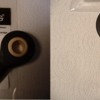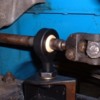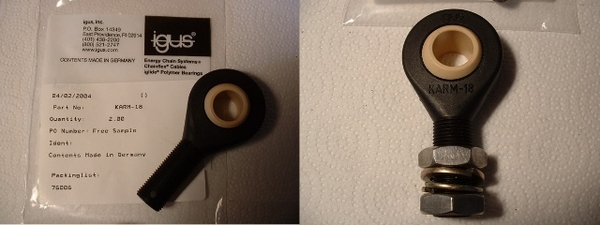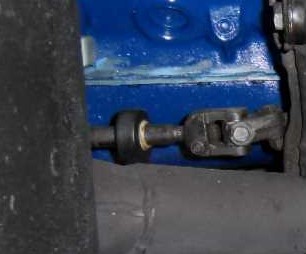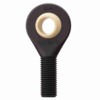Replies sorted oldest to newest
Did you try any of the other Pantera vendors?
I got one from Bobby Byars a few years ago.
John
does this support the shift rod and allows it to rotate AND slide back and forth? and the reason for the spherical ball is for alignment?
quote:Originally posted by JFB #05177:
Would you mind providing a little education for me?
does this support the shift rod and allows it to rotate AND slide back and forth? and the reason for the spherical ball is for alignment?
Yes, it supports the shift rod and allows it to slide back and forth a rotate. The heim joint replaces the stock rubber bushing. The heim joint will prevent the binding of the shift rod in the bushing which maintains the alignment of the shift rod.
Rather than use a large heim joint, you can machine the stock trunion bearing to accept a spherical bearing. Since the ID of the bearing will be too large for the OD of your OE shift rod, you'll need a bushing installed in the bearing. The bushing can be machined from nylon, delrin or some other hard but slippery material.
Ron Siple made one for me years ago, exactly as described, and it's still the best shift shaft support I've seen. I think Ron is registered on the PI web site, so you can contact him via a PM.
quote:Originally posted by Husker:
Pantera Performance in Co. Dennis Quella. He requires the bar to be replaced as he changes the diameter.
quote:Originally posted by Rick:
Yeah, Talked to him already. I just had the rod assembly cleaned up and coated so I'm trying to stick with a stock diameter heim joint if one can be found.
My GT5 was done by Dennis when I got it, I cannot understand why he takes the shaft and turns it down to fit an imperial size heim when the correct metric heims are available.
Rick, for smooth operation you will likely want to remove the coating on the portion that slides through the joint, which may mean removing it all to get the heim on there!
The alternative would be to measure the diameter with coating and get the appropriate size spherical rod end.
Midwest Control has pretty much everything you need in thsi area www.midwestcontrol.com
Julian
I took a trip to my parts trailer and quickly measure my rusty rod at ~0.71" which would possibly be an 18mm. I have worked with rod end bearings in industrial applications and was surprised that 18mm was hard to find. I was looking for economy types and only got a hit at Roush Yates
http://www.roushyatesparts.com...-end-p/fkb-cm18m.htm
now for an 18mm to work the rod diamater needs to be less tha 0.708" preferably 0.705"
I could see short sleeving the rod to go to a standard 3/4", but thinking steel and steel sliding would not be the best
from Nadella in Italy. They're still in business but all or most of the vendors will have a selection of good used u-joints available, far cheaper than importing a new one.
quote:Originally posted by JFB #05177:
some followup photos and your impressions would be appreciated of the part you install
Slick as snot. I shoot the rod end and the shaft with dry teflon spray lubricant at the begining of every driving season. So, it doesn't attract any dirt or grit. No issues to date.
Attachments
Hi all, reviving a very old post. My trunion is very worn, so I am wanting to replace it. This Karm 18 one seems like a good solution, and I just checked and it is still available from simplybearings in the U.K. I am wondering how it was worked out over the years. Did it break or wear out. And if anyone has some updated solutions to what is the best thing to replace the trunion with these days. I don't want to change my shifter rod to larger diameter etc.
Cheers Tim.
Tim, I installed the igus rod end in 2004, and it's still going strong after all these years. I didn't like the idea of using a metal rod end or metal-to-metal anything. So, the igus composite rod end fit the bill with little to no noticeable wear to date. I bought a spare rod end at the time but haven't needed to use it yet.
Enjoy, Ron
Hi Ron,
thanks very much for the report, glad to hear that it has worked out so well. It sounds like the way to go for me.
Cheers, Tim.
P I Motorsports has One on Ebay right now! $89.95 Plus shipping. Good Luck
A couple of comments. The trunnion support joint originally had small rubber bellows on both sides to shield the shift shaft & ball from slop, road grime & keep lube inside. They were regular neoprene and didn't last more than a couple of yrs. I haven't seen one on a Pantera in this century. Might be worth while fabricating some & gluing/clamping them on if you encounter such stuff on the road regularly.
If you have machining capabilities, heim balls are 8740-high-carbon steel but can be quickly cut oversize on a mill or lathe with a sharp cutter (NOT a drill!), slow speed, light cuts & plenty of lube. Skimp on any of those and the cut area will work-harden ahead of the cutter from heat and you just made junk. I haven't tried it but a small brake hone might open up a heim ball. I prefer a mill & carbide cutter. Remember to keep the ball cool while enlarging by any means!
Hi Boss, interesting info on the small rubber bellows, I had thought myself that it would be an excellent solution, akin to what is on the steering rack/, not knowing that they actually did have them originally. It would be a great idea to put them back on when changing the trunion. Because I guess a lot of the wear on the trunion comes from sand and dust sticking to any grease or lube applied. Any ideas where to get them?
Cheers, Tim.
@bosswrench posted:If you have machining capabilities, heim balls are 8740-high-carbon steel but can be quickly cut oversize on a mill or lathe with a sharp cutter (NOT a drill!), slow speed, light cuts & plenty of lube. Skimp on any of those and the cut area will work-harden ahead of the cutter from heat and you just made junk. I haven't tried it but a small brake hone might open up a heim ball. I prefer a mill & carbide cutter. Remember to keep the ball cool while enlarging by any means!
Or you can simply purchase the correct metric heim joint and save yourself a lot of hassle!
The cramped environment where the shifter support lives is hostile to all flexible plastic materials, due to the 150+ F temperature from the left side exhaust close by, vibration, road debris thrown up and oil dripping from the rocker cover above. A heat shield might help. It appears that there are many shifter shaft support rod-ends available commercially- Google "shift shaft support"- I don't know the exact ID or OD diameter we need. There are also some 'steering shaft supports' that look identical. But none show sealing boots. A phone call to steering U-joint makers Borgeson, Flaming River etc might pay off. Not everything can be resolved by e-mail.
Another factor is the roughness of the stock DeTomaso shift shaft tube's OD. To allow any rubber seal to live on a moving tube, the stock tube might have to be removed and polished with a drill press & emery cloth in the area where it runs back & forth in the metal support. This might be why D. Quella's setup requires a certain diameter shaft- not just for the OD thru the support but also for surface smoothness. I would error on the OD toward looseness to keep your rig from seizing up when things get nice & hot.
I haven't had any issues using the 18mm igus composite rod end since I installed it in 2004.
igubal® rod ends are corrosion-resistant can be used without problems in harsh environments. In moist or wet environments, they are resistant to weak acids and alkalines. Their resistance to dirt and dust should be noted.
Housing made from igumid G, an extremely impact-resistant, long-fiber-reinforced polymer. Suitable for temperatures from -40 °C to +90 °C in long-term use.
The spherical ball is made from iglide® L280 material, which is known for lowest coefficients of friction in dry operation and extremely low tendency to stick-slip. This is especially important for low loads and very slow movements.
- Maintenance-free dry operation
- No lubrication
- heavy-duty
- Very high durability in varying loads
- Compensation of misalignment errors
- Compensation of edge loads
- Resistant to dirt, dust and lint
- Resistant to corrosion and chemicals
- High vibration-dampening
- Suitable for rotating, oscillating and linear movements


